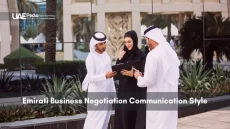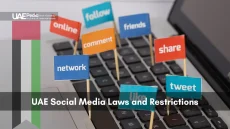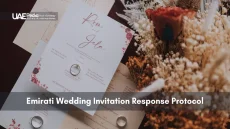Did you know a simple gesture—like which hand you use to pass a dish—could transform a business dinner into a lasting partnership? In a land where golden skylines meet Bedouin hospitality, every meal becomes a dance between heritage and contemporary flair.
From Dubai’s cloud-piercing restaurants to Abu Dhabi’s pearl-inspired private lounges, dining here isn’t just about taste. It’s about reading the room—literally. The right attire (think tailored abayas or crisp linen suits) speaks volumes before you even glance at the menu.
Why does this matter? Because shared meals are bridges here. A well-timed “shukran” to staff or knowing when to linger over cardamom coffee can turn transactions into trust. We’ve watched colleagues stumble over soup spoons and seen friendships bloom over correctly folded napkins.
Unlike Parisian bistros or New York steakhouses, Emirati elegance thrives on subtlety. Dishes arrive like edible art, but conversations stay grounded in warmth. Waitstaff glide silently—yet a raised eyebrow might signal it’s time to switch from mineral water to gahwa.
- Dress codes aren’t suggestions here—they’re respect, woven into fabric choices
- Meals blend ceremony with connection, where every gesture carries weight
- Upscale venues mirror the nation’s soul: futuristic, yet rooted in desert grace
The Cultural Landscape of UAE Dining Etiquette
Picture a saffron-infused biryani served beside date-stuffed camel meat—this is where spice routes and Bedouin heritage collide. Over 200 nationalities shape local food rituals, creating a dining playbook where tradition meets Tokyo-style sushi bars.
Diverse Culinary Traditions and Influences
Every dish tells a migration story. Persian kebabs share menus with Lebanese mezze, while Filipino adobo spices up corporate lunches. During Ramadan, sunset meals become symphonies: sticky luqaimat dough balls passed clockwise, Arabic coffee poured left-handed as hospitality codes demand.
Chefs here are cultural diplomats. One minute you’re using khubz bread as edible cutlery, the next mastering chopsticks for black cod miso. This fusion extends beyond food—waiters blend Malay soft-spoken grace with Swiss precision timing.
Respect and Social Connection in Business Meals
Arriving 10 minutes early isn’t punctuality—it’s respect. Business deals simmer over shared platters, not contracts. Watch Emirati hosts: they’ll taste each dish first to assure guests of quality, a custom rooted in desert survival.
- Women often initiate seating choices—a nod to matriarchal influences in Gulf culture
- Declining third coffee refills? Fold the cup gently—it signals contentment, not rejection
- Meals end when the eldest guest rises, turning feast into farewell
Time bends differently here. A 1 PM lunch might stretch till 3, because trust can’t be microwaved. As a Dubai CEO once told me: “We break bread before we break deals.”
Read More:
UAE Table Manners Formal Settings
Ever notice how a fork’s placement can whisper volumes? In high-end venues, dining becomes chess—every move telegraphs awareness. Here’s how to play gracefully.
Understanding the Formal Dining Rules
Start with posture: sit like your spine knows the skyline’s height. Cutlery follows the “outside-in” rhythm—salad fork first, dessert spoon last. Keep your right hand active for passing dishes (left stays grounded—trust us).
Watch servers’ eyes. A half-empty water glass signals “refill,” while angled bread plates mean “clear.” Business meals pivot on these quiet codes. As a hospitality manager in Dubai confided: “We notice who mirrors our pace—those guests get the rosewater towels first.”
Embracing Local Customs for a Confident Experience
Men, that tailored blazer? It’s armor here. Women, flowing sleeves trump pencil skirts. Your dress isn’t just fabric—it’s a nod to modesty’s modern edge.
Three things to mind:
- Rest elbows lightly—hovering hands suggest impatience
- Let hosts lead conversation to safer topics (family > politics)
- Leave bites on your plate—cleaning it whispers “feed me more”
Adapting isn’t mimicry. It’s saying “I see you” without words. When in doubt, mirror the person to your left—their napkin fold or tea-sipping pause holds clues. After all, confidence here isn’t about knowing every rule. It’s about respecting the dance.
Over 200 nationalities contribute to the UAE’s dining tapestry, creating a vibrant mix of culinary rituals. Ref.: “Dining etiquette in UAE’s multicultural mix” by Asma Samir (2018). Gulf News.
Dressing Appropriately for Formal UAE Dining
Ever wonder why linen suits outrank leather jackets at Abu Dhabi’s waterfront restaurants? Your clothing isn’t just fabric here—it’s a handshake in textile form. At Anantara Eastern Mangroves, crisp linen shirts and flowing maxi dresses aren’t just fashion—they’re silent diplomacy.
Modesty, Elegance, and the Smart Casual Standard
Think breathable layers over bare skin. Men’s tailored blazers pair with open-collar shirts (no ties needed), while women’s elbow-sleeve dresses in jewel tones strike the perfect balance. A concierge at a five-star hotel confides: “Guests in structured shoulders get faster refills—it’s an unspoken code.”
Three rules reign supreme:
- Natural fabrics trump synthetics—trust us, your collar stays crisp
- Neutral palettes with metallic accents whisper “polished,” not flashy
- Closed-toe shoes ground your look, even with ankle-grazing hemlines
Watch how locals fold their napkin—left side for personal use, right reserved for discreetly wiping shared serving spoons. Your plate becomes a canvas: leaving two bites signals satisfaction, while scraping it clean hints at unmet hunger.
Business travelers take note: that structured handbag or leather folio? It’s your visual handshake. “What you wear tells us how seriously you take this meeting,” shares a Dubai hospitality manager. When in doubt, mirror your host’s style intensity—their cufflink choice holds clues.
Remember: dressing well here isn’t vanity. It’s respect translated through thread counts and smart hemlines. After all, in venues where gold-leaf coffee cups meet AI wine pairings, your attire becomes part of the conversation.
Napkin Protocol and Cutlery Handling in the UAE
Ever felt a napkin’s weight speak louder than words? In upscale venues, this folded fabric becomes your silent ally. Master its language, and you’ll glide through seven-course meals like a local.
Proper Napkin Placement and Timing
Unfold your napkin within 10 seconds of sitting—it’s your first “I belong here” signal. Drape it across your lap, not tucked like a bib. For multi-course events, reposition after messy dishes: fold stained sections inward. A Dubai restaurateur shares:
“Guests who leave napkins crumpled on chairs? We remember—and not fondly.”
The Outside-In Approach to Using Cutlery
Start with the outermost fork—salad first, entrée last. Knives stay in the right hand, blades turned inward like a secret handshake. Finished? Lay utensils at 4:20 clock-position. “We notice who mirrors this dance,” confides a private chef in Abu Dhabi.
Communicating with Waitstaff Discreetly
Catch servers’ eyes with a slight chin lift—no finger snaps. Need a refill? Touch your glass’s rim with your left hand. Men and women alike should avoid dramatic gestures—subtlety reigns here. One rule transcends all: let your host lead the conversation, even when requesting extra flatbread.
Three quick tips for any meal:
- Blot—don’t scrub—your mouth to preserve lipstick or beard oil
- Pass dishes clockwise using your right hand as the anchor
- If you step away, leave your napkin on the seat—not the table
Aggressive scrubbing with your napkin can smear lipstick or beard oil—always blot gently to maintain a refined appearance. Ref.: “Dining Etiquette for Business Meals” by APE AE (2025).
Business Lunch & Dinner Etiquette in Arab Culture
Business here simmers slowly, marinated in cardamom coffee and shared platters. Meals stretch like desert horizons—every bite building bridges between spreadsheets and souls. This isn’t transactional dining. It’s relationship alchemy.
Building Lasting Relationships Over Meals
In the Middle East, your food plate becomes a trust meter. Let hosts serve you first—declining hints distrust. Compliment the saffron rice lavishly. A hospitality director in Abu Dhabi advises:
“Ask about spice blends before discussing contracts. Shared curiosity opens doors.”
Three rules for connection:
- Leave phones face-down—eye contact proves priorities
- Use your right hand to pass dishes, left resting palm-up
- Discuss family before finance—grandchildren stories > gross margins
Tactful Handling of the Bill and Follow-Up Gestures
The bill arrives like a test. Locals often insist on paying—protest once, then graciously yield. If hosting, discreetly hand your card to staff beforehand. Make sure to praise the venue’s ambiance when settling.
Follow-ups matter more than forks. Send handwritten notes referencing specific dishes. A CEO shares: “I remember who mentions my mother’s lamb recipe—those get my calendar first.” Small gifts? Think dates from your hometown, not luxury items.
In Abu Dhabi’s aspect dining scenes, modern efficiency meets age-old codes. Servers intuit needs—refilling waters before asked, replacing bread baskets silently. Mirror their rhythm: deliberate, observant, always leaving space for generosity to bloom.
Cultural Do’s and Don’ts at the UAE Dinner Table
Your elbow’s position during mezze platters could be your silent business card. In this crossroads of global cultures, dining becomes a masterclass in unspoken dialogue—where every tilt of the head or palm placement sends signals sharper than words.
The Silent Vocabulary of Shared Meals
Posture speaks first. Sit tall but relaxed—stiffness reads as discomfort, slouching as indifference. Keep both wrists lightly touching the table’s edge, a balance between engagement and patience. During a recent business lunch, an Emirati CEO shared:
“When someone mirrors my seated posture, I know they’re truly present.”
| Gesture | Do’s | Don’ts |
|---|---|---|
| Hand Placement | Right hand visible above the table | Fidgeting with utensils |
| Eye Contact | Brief, warm glances during toasts | Staring during chewing |
| Head Movements | Nodding slightly while listening | Tilting head back mid-conversation |
Notice how locals handle bread—tearing gently rather than cutting. This subtle act honors Bedouin traditions of resourcefulness. At international gatherings, blending this with universal practices (like waiting for hosts to eat first) builds bridges.
Three quick lessons from hospitality pros:
- Crossing legs? Keep soles hidden—it’s considered rude in many Gulf cultures
- Receive dishes with both hands—a gesture borrowed from Asian etiquette
- Laugh softly—boisterous tones can disrupt the meal’s rhythm
These codes aren’t about perfection. They’re invitations to show you value local heritage. As one Dubai restaurateur told me: “We forgive missteps, but reward genuine effort.” Master these cues, and you’ll navigate diverse places around the world with the same confidence.
Modern Influences on Traditional Dining Etiquette
Imagine biting into a sushi roll wrapped with khubz bread—this is where centuries-old traditions meet tomorrow’s tastes. Across upscale venues, chefs now balance ancestral recipes with molecular gastronomy, creating spaces where robot servers deliver date-glazed foie gras. The rules? They’re shifting—but not disappearing.
Fusion Cuisine and Evolving Service Standards
Menus once heavy on lamb and rice now feature truffle-smoked camel burgers and gold-leaf shawarma. Waitstaff trained in Parisian techniques adapt to local rhythms—pausing longer between courses for storytelling. A restaurateur in Dubai Marina notes:
“Guests want innovation, but we’ll never serve seafood with the left hand—that’s non-negotiable.”
| Traditional Custom | Modern Adaptation | Key Balance |
|---|---|---|
| Hand-served coffee | AI-powered pour timing | Tech respects ritual pacing |
| Floor seating | Low-lying designer banquettes | Comfort honors heritage |
| Shared platters | Individual tasting menus | Intimacy meets community |
Three tips for navigating this blend:
- Observe staff behavior—they often bridge old and new norms
- When unsure, prioritize respect over novelty (e.g., still decline pork offers politely)
- Compliment fusion dishes using local terms—“mashallah” works better than “instagrammable”
Even Michelin-starred spots keep essentials intact. Notice how molecular etiquettes appear: liquid nitrogen theatrics pause when elders arrive. As one chef told us: “We’re rewriting recipes, not erasing roots.” Your role? Stay curious, mirror gestures, and let the meal teach you.
Innovative dishes may surprise, but deviating too far from key rituals—like hand‐pouring Arabic coffee—can disrupt cultural harmony. Ref.: “Dining etiquette in UAE” by Elegante Emirates (2023).
Closing Reflections on Navigating UAE Dining Experiences
Consider the quiet power of a shared dessert spoon—it’s more than cutlery, it’s cultural shorthand. We’ve learned that every gesture here carries weight, from how coffee cups are held to the way cutlery rests between courses. These moments build bridges faster than any contract.
Mastering local customs isn’t about perfection. It’s showing you value traditions that have shaped meals for generations. Whether navigating business lunches across countries or family feasts, small choices—like using cutlery from the outside in—signal respect louder than words.
Three lessons stay with us:
- Observe first, then participate (your host’s lead is the best guide)
- Adapt as you explore different countries—each culture adds new layers to your etiquette toolkit
- Let genuine curiosity override nerves; most locals appreciate effort more than flawless execution
These practices transform meals into meaningful exchanges. You’ll find saffron rice tastes richer when shared with awareness, and cardamom coffee lingers sweeter when sipped with cultural grace. Keep learning—whether mastering cutlery codes or regional greetings—and let every bite deepen connections.
What dining moment surprised you? Share stories from various countries. After all, we’re all students at this ever-evolving table.
Opt for modest, elegant attire—think tailored suits for men and knee-length dresses with sleeves for women. Avoid sheer fabrics, tight fits, or flashy logos. When in doubt, "smart casual" leans conservative here. A lightweight shawl doubles as a chic accessory and respectful cover-up.
In Arab culture, the left hand is traditionally reserved for personal hygiene. Use your right hand for passing dishes, shaking hands, or eating finger foods like dates. No stress if you’re using cutlery—just keep that left palm resting casually on your lap.
Gifts aren’t expected but are appreciated—opt for quality dates, artisanal coffee, or perfume. Present items with your right hand or both hands. Avoid alcohol or overly personal gifts. A heartfelt shukran (thank you) during the meal works wonders too!
Gently fold your napkin and leave it on your chair—not the table—to signal you’ll return. If the meal’s finished, place it loosely to the left of your plate. No dramatic flourishes needed; subtlety keeps things classy.
Unlike some cultures, leaving a small bite shows your host provided ample hospitality. Clean plates might prompt more servings! For business lunches, pace yourself—meals often have multiple courses, from mezze to fragrant biryanis.
Send a thank-you message within 24 hours, referencing a specific dish or conversation topic. If you’re the guest, let your host handle the bill—but offering once shows goodwill. Future meetings? Propose a majlis-style coffee chat to continue building rapport.
Absolutely! While respecting core traditions like handshakes and modest dress, Dubai’s cosmopolitan scene blends global etiquette. Watch your host: if they use chopsticks for sushi or fork-and-knife for machboos, mirror their approach. When in doubt, “follow the leader” keeps things smooth.















